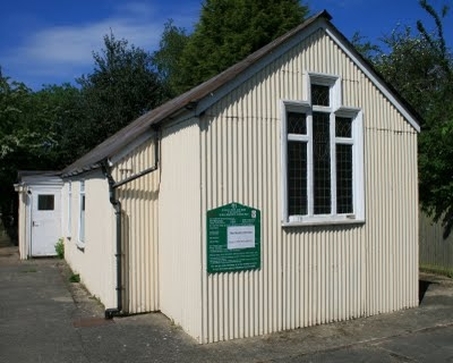
St Mary's Church Room was constructed in 1889 by local residents, from a kit of parts delivered to the sidings at Sole Street Station. It is one of the oldest “Tin Tabernacles” still in use in Great Britain . It was opened by the Rev G Blandford, vicar of St Lukes, South Hackney on 14 March 1889. The vicar of Cobham at the time was Rev Arthur H Berger. It is believed to be the only surviving Tin Tabernacle with a stained glass window
A tin tabernacle, also sometimes known as a tin chapel, was a "temporary" building constructed from corrugated iron built during the late Victorian era and used for religious worship.
The late Victorian period was a time of religious missionary zeal and the Anglican church sought to spread the word particularly in rural areas such as Kent. Farm labourers and seasonal hop pickers would often find themselves living many miles walk from the nearest parish church.
To overcome this problem, tin tabernacles were built in the countryside as satellites of the parish churches. The minister would travel out to the tin tabernacle to deliver the Sunday sermon to the farm labourers and their families.
The Tin tabernacle was sold in kit form at a cost of about £100 and delivered by train to Sole Street Station being constructed at weekends by the congregation. The land given by the Baker family was formerly part of Yeomans’ garden. The hall was officially opened in 1889.
The hall was modernized in the 1940/50s at a time of austerity, consequently to a very low standard, with the addition of the front porch, lean-to kitchen and toilet as well as the level of the chancel floor being raised.
Although the tin tabernacles were only intended to be temporary structures in lieu of a more permanent building some can still be found in Kent well over one hundred years later.
At present there is a major community project the repair and develop St Mary's Meeting Room lead by Su Rowe of Sole Street House ably assisted by a group of enthusiastic local residents
A tin tabernacle, also sometimes known as a tin chapel, was a "temporary" building constructed from corrugated iron built during the late Victorian era and used for religious worship.
The late Victorian period was a time of religious missionary zeal and the Anglican church sought to spread the word particularly in rural areas such as Kent. Farm labourers and seasonal hop pickers would often find themselves living many miles walk from the nearest parish church.
To overcome this problem, tin tabernacles were built in the countryside as satellites of the parish churches. The minister would travel out to the tin tabernacle to deliver the Sunday sermon to the farm labourers and their families.
The Tin tabernacle was sold in kit form at a cost of about £100 and delivered by train to Sole Street Station being constructed at weekends by the congregation. The land given by the Baker family was formerly part of Yeomans’ garden. The hall was officially opened in 1889.
The hall was modernized in the 1940/50s at a time of austerity, consequently to a very low standard, with the addition of the front porch, lean-to kitchen and toilet as well as the level of the chancel floor being raised.
Although the tin tabernacles were only intended to be temporary structures in lieu of a more permanent building some can still be found in Kent well over one hundred years later.
At present there is a major community project the repair and develop St Mary's Meeting Room lead by Su Rowe of Sole Street House ably assisted by a group of enthusiastic local residents
